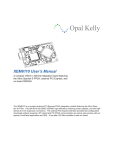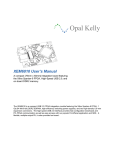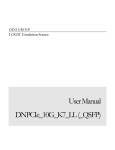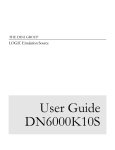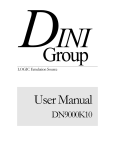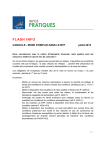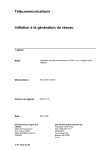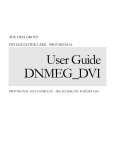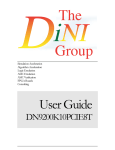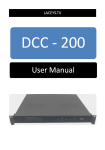Download MEG Array Daughter Card Interface Description
Transcript
LOGIC Emulation Source Daughtercard Interface Description D A U G H T E R C A R D S P E C I F I C A T I O N 1 Dini Group Meg-Array Daughter card Interface This file describes the Dini Group’s standard daughter card interface. The interface provides 186 signals from a host board to a daughter card. These signals are high-speed, flexible and differentially capable. The daughter card interface is built around a 400-pin FCI “MegArray” connector. This BGA array of pins is designed for high-speed high-density board-to-board connections. The “Plug” of the system is located on the host, and the “receptacle” is located on the expansion board. This selection was made to give a greater height selection to the daughter card designer. The user typically designs his own daughter card with interfaces required for the emulation project. The Dini Group is happy to review daughter card designs intended for interface to a Dini Group host for possible compatibility problems. A daughter card designer should use the schematic of the host board (provided with the board) to verify his design. 1.1 Banking System To allow flexibility to the daughter card designer, the daughter card interface is divided into three “Banks”. Each bank can have it’s own VCCO power, VREF (threshold voltage) and source-synchronous IO clocking. Each bank contains 62 user IO signals (can be used as 31 differential pairs). Eight of these signals can be used as a source-synchronous clock into the host FPGA. Four of these signals can be used as a reference voltage to the host fpga for standards requiring a reference voltage. The banks are named B0, B1 and B2, and every user IO on the header interface corresponds to one of these banks. The signals name given to each user IO pin contains either “B0”, “B1”, or “B2” in the name. Other connections on the daughter card connector system (not correlated to a bank) include three dedicated, differential clock connections for inputting global clocks from an external source, power connections, bank VCCO power, a buffered power on reset signal. 1.2 Non-Compliant Boards See section 4.2 of this guide for deviations from this specification. 2 Daughter Card Electrical The daughter card pin out and routing were designed to allow use of the Virtex-4’s 1 Gbps general purpose IO. The connector itself is capable of as high as 10Gbs transmission rates using differential signaling. All signals on the host are all routed as differential, 50-Ohm transmission lines, with means to properly terminate. All signals are routed against a ground plane, so for the best signal integrity, should be routed against a ground plane on the daughter card with excellent Daughter Card Specification www.dinigroup.com 2 D A U G H T E R C A R D S P E C I F I C A T I O N IO voltage bypassing close to the terminus. When signals are used differentially, the trace impedance is 100-ohms. Signals on the host are not length-matched, except for each signal in a differential pair, which are. Differential pairs are routed in parallel, but not closely coupled to make single-ended signaling possible. Using the IDELAY and ODELAY (Stratix devices adaptive delay) elements on the FPGA, the skew between mismatched signals can be corrected. Most pins are assigned in a GSG pattern to minimize crosstalk. Some signals are arranged in a GSSG pattern. (Pins in column E and F) 2.1.1 DCI Host boards whose FPGAs that have DCI (digitally controlled impedance) capabilities have DCI enabled with a 50-ohm reference resistor. This allows LVCMOS_DCI and SSTL_DCI IO standards to be used. 2.2 Daughter card Signals Bank 0 (VCCO0) includes the signals BL[0-31]. Bank 1 (VCCO1) includes B1L[0-31]. Bank 2 (VCCO2) includes signals B2L[0-31] Special purpose pins are described below. 2.2.1 Clock Outputs These signals are used for sending a clock signal (differential) from the daughter card to the host. The pair GCAP/GCAN (Pairs E1, F1) can be used as a SSTL18, SSTL25, LVDS differential pair, or GCAP can be used single-endedly as LVCMOS25. These signals only connect to the FPGA associated with the connector. The pair GCBP/GCBN (E3, F3) can be used as a SSTL18, SSTL25, LVDS differential pair, or GCAP can be used single-endedly as LVCMOS25. These signals only connect to the FPGA associated with the connector. The pair GCCP/GCCN (Pair E5, F5) must be used as an LVDS pair. This differential clock is buffered and distributed to every FPGA on the host. This clock may be de-skewed on the host through a zero-delay buffer. If this is the case (DN7000K10PCI, DN8000K10, DN9000K10PCI) there may be special frequency requirements or settings for the buffers to work. See the user manual for the specific board for these requirements. This clock network may also be multi-purpose, so a setting may have to be used to enable this clock distribution. 2.2.2 User IO User IO signals connect directly to a general-purpose IO site on the host FPGA. These signals can be used as any drive standard supported by the host FPGA. Each bank must share VCCIO and VREF requirements. For example, if bank B0 is supplied 1.8V by the daughter card on Daughter Card Specification www.dinigroup.com 3 D A U G H T E R C A R D S P E C I F I C A T I O N ALL of the VCCIO_B0 pins, and supplies 0.9V to ALL of the VREF_B0 pins, then the daughter card may use each of the user IO pins as 1.8V SSTL inputs or outputs, LVDS outputs, 1.8V LVCMOS inputs or outputs, since all of these signal standards’ requirements are met. User IO signals can be used single-endedly, or differentially. Differential pairs are pre-selected. Each set of signals whose signal names differ only by a “p” or “n” in the signal name can be used as differential pairs. For example, the signals B2_L4p and B2_L4n can be used as a differential pair. These two signals are matched in length. 2.2.3 IO Clock Some of the signals connected to the daughter card expansion headers are “clock-capable”; the inputs on the host FPGA can be used for source-synchronous clocking. On Virtex-4 devices, these pins have “CC” in the name. The CC pins on each bank are suitable for IO, sourcesynchronous clocking for all signals on that bank. A CC clock can only be used to clock signals on the bank associated with it. If source-synchronous clocking is not required, these signals can be used as “User IO”. On Virtex-4 (DN8000K10 series) the host cannot drive LVDS signals on these pins, due to a hardware constraint. 2.2.4 VREF Pins declared as “VREF” pins by Xilinx have a defined placement on the daughter card pin out to allow the daughter card to define a logic threshold as required by some standards. If you want to use a standard with a VREF (SSTL15, SSTL15, SSTL18, HSTL15, HSTL18, HSLVCMOS33) the daughter card should supply this reference voltage on these pins. For optimal performance, capacitors should be installed on the host board on these signals near the host’s FPGAs. Space provisions for these capacitors have been provided. If VREF is not required by the intended signaling standard, then these signals can be used as “User IO” without restriction. 2.2.5 Power The +3.3V, +5.0V and +12V power rails are supplied to the Daughter card headers. Each pin on the MegArray connector is rated to tolerate 1A of current without thermal overload. Most of the power available to daughter cards through the connector comes from the two 12V pins, for a total of 24W. The host provides a fuse on each of these rails. 2.2.6 IO Power The signaling standard of the daughter card is left undefined by the host. For a standard to be used, the daughter card should supply power to the VCCIO pins of the daughter card connector. The pins are connected directly to the VCCIO power pin on the host FPGA. Each of the three banks on the daughter card has two VCCIO pins. Each of the three banks can have its VCCIO set independently, but both pins on a bank must be the same voltage. The daughter card should be able to supply enough current to the host FPGA to power the entire bus. The daughter card designer will need to calculate the host FPGA’s current requirements. Daughter Card Specification www.dinigroup.com 4 D A U G H T E R C A R D S P E C I F I C A T I O N When the daughter card does not supply a voltage the host, the host will power these pins at 1.2V with a minimal current capacity. The daughter card can overdrive this voltage safely. 2.2.7 Reset The reset signal (Active low) is an open-drain, buffered copy of the reset signal on the host. This signal is asserted when the host power is not within tolerance. The signal must be pulled up on the daughter card with a resistor. When the reset signal is active, the FPGAs on the host will not be configured. F7 7A +5.0V F6 5A +12.0V F5 5A P100- 1 A1 K1 C1 H1 2 DC_RSTn 1 B2 D2 G2 +3.3V U254 A VCC O.D. Y NC GND 5 4 3 74LVC 1G 07 SOT95P280- 5N DC0_RSTn J2 P12V_1 P12V_2 P5V_1 P5V_2 P3.3V_1 P3.3V_2 P3.3V_3 GCAP GCAN 1A PER PIN +3.3V GCBP GCBN GCC P GCC N E1 F1 E3 F3 E5 F5 DC0_GCAP 104 DC0_GCAN 104 DC0_GCBP 104 DC0_GCBN 104 DC0_GCC P 85 DC0_GCC N 85 RSTn Section 1 of 5 Clock, Power, Reset MEG -Ar ray 300-Pi n The RSTn signal to the daughter card is an open-drain, buffered copy of the SYS_RSTn signal. This signal causes the entire DN8000K10 to reset, losing all FPGA configuration data and resetting the configuration circuitry. 2.3 Pin out The following lists are the pin assignments to the MEG Array connector. The pins are labeled as in the FCI connector part drawing. 2.3.1 Clock and Reset Signals F1 E1 GCAP GCAN E3 F3 GCBP GCBN E5 F5 GCCP GCCN J2 RSTn Daughter Card Specification www.dinigroup.com 5 D A U G H T E R C A R D 2.3.2 Power Signals A1 K1 +12V +12V C1 H1 +5V +5V B2 D2 G2 +3.3V +3.3V +3.3V 2.3.3 A10 A12 A14 A16 A18 A2 A22 A24 A26 A28 A30 A34 A36 A38 A4 A40 A8 2.3.4 S P E C I F I C A T I O N Ground Signals B3 B1 B13 B11 B5 B9 B7 B23 B21 B15 B19 B27 B25 B17 B29 B31 B33 B35 B37 B39 C14 C22 C8 C2 C24 C4 C10 C18 C16 C6 C20 C12 C26 C28 C30 C32 C34 C36 C38 C40 D1 D11 D13 D15 D17 D19 D21 D23 D25 D27 D29 D3 D31 D33 D35 D37 D39 D5 D7 D9 E10 E12 E14 E16 E18 E2 E20 E22 E24 E26 E28 E30 E32 E34 E36 E38 E4 E40 E6 E8 F10 F12 F14 F16 F18 F2 F20 F22 F24 F26 F28 F30 F32 F34 F36 F38 F4 F40 F6 F8 G1 G11 G13 G15 G17 G19 G21 G23 G25 G27 G29 G3 G31 G33 G35 G37 G39 G5 G7 G9 K10 K12 K14 K16 K18 K2 K22 K24 K26 K28 K30 K34 K36 K38 K4 K40 K8 J1 J11 J13 J15 J17 J19 J21 J23 J25 J27 J29 J3 J31 J33 J35 J37 J39 J5 J7 J9 H10 H12 H14 H16 H18 H2 H20 H22 H24 H26 H28 H30 H32 H34 H36 H38 H4 H40 H6 H8 Bank B0 IO Pins shaded yellow are “CC” pins A3 B4 C3 D4 H3 G4 K3 J4 A5 DCC0P1 DCC0N1 DCC0P2 DCC0N2 DCC0P3 DCC0N3 DCC0P4 DCC0N4 DCC0P5 N22 N23 H29 H30 N27 P27 K32 K33 M25 Daughter Card Specification www.dinigroup.com 6 D A U G H T E R C A R D B6 C5 D6 H5 G6 K5 J6 A7 B8 C7 D8 E7 F7 H7 G8 K7 J8 A9 B10 C9 D10 E9 F9 H9 G10 K9 J10 A11 B12 C11 D12 E11 F11 H11 G12 K11 J12 A13 B14 C13 D14 E13 F13 H13 G14 K13 J14 A15 S P E C I F I C A T I O N DCC0N5_VR DCC0P6 DCC0N6 DCC0P7 DCC0N7 DCC0P8 DCC0N8_VR DCC0P9 DCC0N9_VR DCC0P10 DCC0N10 DCC0P26 DCC0N26 DCC0P11 DCC0N11 DCC0P12 DCC0N12_VR DCC0P13_C DCC0N13_C DCC0P14 DCC0N14 DCC0P27 DCC0N27 DCC0P15 DCC0N15 DCC0P16_C DCC0N16_C DCC0P17_C DCC0N17_C DCC0P18 DCC0N18 DCC0P28 DCC0N28 DCC0P19 DCC0N19 DCC0P20_C DCC0N20_C DCC0P21 DCC0N21 DCC0P22 DCC0N22 DCC0P29 DCC0N29 DCC0P23 DCC0N23 DCC0P24 DCC0N24 DCC0P25 M26 J27 K27 G32 G33 M30 M31 H32 J32 C32 D32 J34 K34 K28 K29 N25 P26 D34 E34 H27 H28 N29 N30 F33 F34 R22 R23 L30 L31 L28 L29 L33 L34 J29 J30 G30 G31 P24 R24 M27 M28 M32 M33 P22 R21 E32 E33 H33 Daughter Card Specification www.dinigroup.com 7 D A U G H T E R C A R D B16 C15 D16 F15 E15 DCC0N25 DCC0P0 DCC0N0 DCC0N30 DCC0P30 2.3.5 Bank B1 IO S P E C I F I C A T I O N H34 P20 R19 C34 C33 Pins shaded yellow are “CC” pins H15 G16 K15 J16 A17 B18 C17 D18 E17 F17 H17 G18 K17 J18 A19 B20 C19 D20 E19 F19 H19 G20 K19 J20 A21 B22 C21 D22 E21 F21 H21 G22 K21 J22 A23 B24 C23 DCC1P1 DCC1N1 DCC1P2 DCC1N2 DCC1P3 DCC1N3 DCC1P4 DCC1N4 DCC1P26 DCC1N26 DCC1P5 DCC1N5 DCC1P6 DCC1N6 DCC1P7 DCC1N7_VR DCC1P8 DCC1N8 DCC1P27 DCC1N27 DCC1P9 DCC1N9 DCC1P10 DCC1N10_VR DCC1P11 DCC1N11_VR DCC1P12 DCC1N12 DCC1P28 DCC1N28 DCC1P13 DCC1N13 DCC1P14 DCC1N14_VR DCC1P15_C DCC1N15_C DCC1P16 B21 A21 E28 F28 A30 B30 K24 J24 D24 D25 G27 G28 D30 D31 C29 C30 C22 B22 D29 E29 J25 K26 F29 F30 G25 H25 F25 F26 L25 L26 B25 C25 D27 E27 A31 B31 C23 Daughter Card Specification www.dinigroup.com 8 D A U G H T E R C A R D D24 E23 F23 H23 G24 K23 J24 A25 B26 C25 D26 E25 F25 H25 G26 K25 J26 A27 B28 C27 D28 H27 G28 K27 J28 2.3.6 DCC1N16 DCC1P29 DCC1N29 DCC1P17 DCC1N17 DCC1P18_C DCC1N18_C DCC1P19_C DCC1N19_C DCC1P20 DCC1N20 DCC1P30 DCC1N30 DCC1P21 DCC1N21 DCC1P22_C DCC1N22_C DCC1P23 DCC1N23 DCC1P24 DCC1N24 DCC1P25 DCC1N25 DCC1P0 DCC1N0 S P E C I F I C A T I O N C24 B32 B33 A28 A29 B28 C28 B27 C27 B23 A23 E31 F31 D26 E26 F23 E23 A26 B26 A24 A25 G23 H24 F24 E24 Bank B2 IO Pins shaded yellow are “CC” pins E27 F27 A29 B30 C29 D30 E29 F29 H29 G30 K29 J30 A31 B32 C31 D32 E31 DCC2P28 DCC2N28 DCC2P30 DCC2N30 DCC2P2 DCC2N2 DCC2P29 DCC2N29 DCC2P3 DCC2N3 DCC2P4 DCC2N4 DCC2P5 DCC2N5_VR DCC2P6 DCC2N6 DCC2P25 N32 P32 P30 P31 T24 T25 AB31 AA31 Y29 W29 W27 V27 R27 R28 T23 U23 P29 Daughter Card Specification www.dinigroup.com 9 D A U G H T E R C A R D F31 H31 G32 K31 J32 A33 B34 C33 D34 E33 F33 H33 G34 K33 J34 A35 B36 C35 D36 E35 F35 H35 G36 K35 J36 A37 B38 C37 D38 E37 F37 H37 G38 K37 J38 A39 B40 C39 D40 E39 F39 H39 G40 K39 J40 S P E C I F I C A T I O N DCC2N25 DCC2P7 DCC2N7 DCC2P8 DCC2N8_VR DCC2P9 DCC2N9_VR DCC2P10 DCC2N10 DCC2P26 DCC2N26 DCC2P11 DCC2N11 DCC2P12 DCC2N12_VR DCC2P13_C DCC2N13_C DCC2P14 DCC2N14 DCC2P27 DCC2N27 DCC2P15 DCC2N15 DCC2P16_C DCC2N16_C DCC2P17_C DCC2N17_C DCC2P18 DCC2N18 DCC2P1 DCC2N1 DCC2P19 DCC2N19 DCC2P20_C DCC2N20_C DCC2P21 DCC2N21 DCC2P22 DCC2N22 DCC2P0 DCC2N0 DCC2P23 DCC2N23 DCC2P24 DCC2N24 R29 U30 U31 Y31 W31 V28 V29 W32 V32 AB32 AB33 U26 U27 T28 U28 N33 N34 V23 V24 AA33 AA34 T33 T34 Y32 Y33 W30 V30 V33 V34 R26 T26 R31 T31 P34 R34 U32 U33 V25 U25 Y27 Y28 T29 T30 R32 R33 Daughter Card Specification www.dinigroup.com 10 D A U G H T E R C A R D 2.3.7 S P E C I F I C A T I O N VCCIO Signals VCCO corresponds to bank B0, VCC1 corresponds to bank B1, VCC2 corresponds to bank B2. K6 A6 VCCO0 VCCO0 K20 A20 VCCO1 VCCO1 A32 K32 VCCO2 VCCO2 Daughter Card Specification www.dinigroup.com 11 D A U G H T E R C A R D S P E C I F I C A T I O N Daughter Card Specification www.dinigroup.com 12 D A U G H T E R C A R D S P E C I F I C A T I O N 2.4 VCCO bias generation Since a daughter card will not always be present on a daughter card connector, a VCCO bias generator is used on the motherboard for each daughter card bank to keep the VCCO pin on the FPGA within its recommended operating range. The VCCO bias generators supply +1.2V to the VCCO pins on the FPGAs, and are back-biased by the daughter card when it drives the VCCO rails. The VCCO voltage impressed by the daughter card should be less than 3.75 to prevent destruction of the Virtex 4 IOs connected to that daughter card. +5.0V U271 8 5 3 6 7 IN OUT 1 SHDN # DC0_B0_VCCO C1803 0.01uF R452 0 380mA MAX AT 1.22V GND 1 GND 2 BYP GND 3 ADJ 4 2 Vadj = 1.22V LT1763CS8 SOIC127P600-8N R467 10.0K 380mA MAX AT 1.22V 3 Daughter card Mechanical Daughter card expansion headers are located on the bottom side of the PWB. This is done to eliminate the need for resolving board-to-board clearance issues, assuming the daughter card uses no large components on the backside. Daughter Card Specification www.dinigroup.com 13 D A U G H T E R C A R D S P E C I F I C A T I O N Each host with a daughter card interface makes certain minimal provisions for daughter cards. Enough space is reserved for each daughter card plug to accommodate the following hypothetical daughter card. (The DNMEG_OBS400 conforms to these dimensions) Note that the components on the topside of the daughter card and DN8000K10 face in opposite directions. 2.75" View: Top Side 400-Pin Receptacle on Back P/N: 74390-101 View: Top Side 300-Pin Receptacle on Back P/N: 84553-101 5.000" Type 0/1/4 Short 4.250" Type 2 Short 3.250" 5.000" 2.75" A1 1.950" 0.750" 0.500" A1 0.500" 1.950" At least four mounting positions are provided for each header in a standard location, as shown above. Boards that have multiple daughter card connectors next to each other (horizontally) use a standard spacing of 78.25mm (3.08in) from pin A1 to pin A1. (and aligned vertically) The connectors used in the expansion system on the host are FCI MEG-Array 400-pin plug, 6mm, part #84520-102. A suitable mating connector for use on a daughter card would be FCI Daughter Card Specification www.dinigroup.com 14 0.500" D A U G H T E R C A R D S P E C I F I C A T I O N part 74390-101 (lead-free 74390-101LF). This provides the minimum board-to-board spacing. Other spacings are possible with different connectors on the daughter card. 3.1.1 Daughter card mounting DN8000K10 The DN8000K10 features a standard metal base plate that gives the board mechanical stability, and provides plenty of mounting points for daughter cards. The daughter card receptacle on the daughter card itself will also be mounted on the backside of the board. Daughter Card Mated Height 14mm RECEPT Shield PLUG 0.200" Motherboard The daughter card should use standoffs to secure itself to the backside of the base plate. The standard chassis that comes with the DN8000K10 will allow it to operate FPGA side down, or on its side to allow physical access to the daughter card and the controls of the DN8000K10. With this host-plate-daughter card arrangement, there is a limited Z dimension clearance for backside components on the daughter card. This dimension is determined by the daughter card designer’s part selection for the MegArray receptacle. 3.1.2 Insertion and removal Due to the small dimensions of the very high speed MegArray connector system, the pins on the plug and receptacle of the Meg Array connectors are very delicate. When plugging in a daughter card, make sure to align the daughter card first before pressing on the connector. Be absolutely certain that both the small and the large keys at the narrow ends of the Meg Array line up BEFORE applying pressure to mate the connectors! Daughter Card Specification www.dinigroup.com 15 D A U G H T E R C A R D S P E C I F I C A T I O N Place it down flat, then press down gently. The following two excerpts are taken from the FCI application guide for the Meg Array series of connectors. A part can be started from either end. Locate and match the connector’s A1 position marking (“?”) for both the Plug and Receptacle. (Markings are located on the long side of the housing.) Rough alignment is required prior to connector mating as misalignment of >0.8mm could damage connector contacts. Rough alignment of the connector is achieved through matching the Small alignment slot of the plug housing with the Small alignment key of the receptacle housing and the Large alignment slot with the Large alignment key. Both connector housings have generous lead-in around the perimeter and will allow the user to blind mate assemble the connectors. Align the two connectors by feel and when the receptacle keys start into the plug slots, push down on one end and then move force forward until the receptacle cover flange bottoms on the front face of the plug. Dec 09, 2004 Like mating, a connector pair can be unmated by pulling them straight apart. However, it requires less effort to un-mate if the force is originated from one of the slot/key ends of the assembly. (Reverse procedure from mating) Mating or un-mating of the connector by rolling in a direction perpendicular to alignment slots/keys may cause damage to the terminal contacts and is not recommended. 4 Dini Group products 4.1 Board List The following boards comply with this document’s header specifications: Daughter Card Specification www.dinigroup.com 16 D A U G H T E R C A R D S P E C I F I C A T I O N DN7000K10PCI DN8000K10 DN8000K10PSX DNMEG_S2GX 3 Headers 11 Headers (7 are non-standard) 1 Header 1 Header Coming Soon: DN9000K10PCI DNMEG_ADC 3 Headers 1 Header 4.2 Exceptions The following products have headers that do not fully comply with these specification. A list of exceptions to this specification follows, with a description of the deviation. 4.2.1 DN8000K10PSX GCCP/GCCN is not deskewed on the host. FPGAs on the host will receive this signal synchronized with respect to each other, but with no phase relationship with the daughter card. 4.2.2 DN8000K10 Daughter cards D0, D1, D2, D3, D4, D9 use 300-pin Meg Array connectors instead of 400-pin. The signal definitions remain the same, except that pin rows 29-40 are not present, and the connector supports two banks (B0, B1) instead of three. DC0 and DC3 do not comply with these specifications. See the DN8000K10 user guide and schematic. (These headers are used for RocketIO signaling) These signals are routed as 110-ohm differential pairs, instead of 100-Ohm. DC10 is reserved for Dini Group use and should not be used for a custom daughter card without the cooperation of Dini Group. 4.2.3 DN7000K10PCI Banks B0 and B1 must be set to the same VCCIO voltage. These two nets are connected on the host. 4.2.4 DNMEG_S2GX Note that only DC_TOP (P4) is a daughter card header that complies with this specification. P5 is the receptacle for a host board. 4.2.5 DN9000K10 On headers DC4 and DC9, VCCO is shared between some banks. See the User Manual for a complete description of this deviation. 4.3 Standard Daughter cards The Dini Group has some general-purpose daughter cards available. See the Dini Group website for more information. Daughter Card Specification www.dinigroup.com 17 D A U G H T E R C A R D 4.3.1 S P E C I F I C A T I O N DNMEG_OBS400 The breakout daughter card provides 48 signals on Mictor connector, 124 signals on .1” pitch headers arranged for differential signaling, 14 differential coax cable connection (intended for use with the DN8000K10 rocketIO headers) and global clock inputs. 4.3.2 DNMEG_OBS300 The DNMEG_OBS300 is identical to the DNMEG_OBS400 except that the receptacle is a 300-pin instead of a 400-pin connector. This can only be used with DC0, DC1, DC2, DC3, DC4, DC9 on the DN8000K10. 4.3.3 DNMEG_S2GX This board provides a Stratix 2 GX FPGA, capable of 6.5Gbs serial data transmission. And some memory options. The DNMEG_S2GX also has a daughter card header configured as a pass-through from it’s own daughter card receptacle. 4.3.4 DNMEG_ADC (coming soon) This board provides a high-speed ADC and DAC, 1Gb Ethernet, Virtex-4 SX55 FGPA, and Memory options. 4.3.5 DNMEG_DVI (coming soon) This board provides dual DVI-D input and output and memory options. 4.3.6 DNMEG_ARM (coming soon) Arm processor Daughter Card Specification www.dinigroup.com 18 D A U G H T E R C A R D 4.3.7 S P E C I F I C A T I O N DNMEG_PROTO (coming soon) Prototype area Daughter Card Specification www.dinigroup.com 19



















